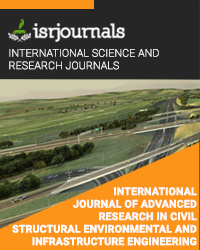study on properties of fibre reinforced concrete with partial replacement of coarse aggregate by steel slag
N.Manoj,N.Nandhini
Published in International Journal of Advanced Research in Civil,Structural,Environmental and Infrastructure Engineering and Developing
ISSN: 2320-723X Impact Factor:1.7 Volume:1 Issue:2 Year: 08 March,2014 Pages:39-44

Abstract
Fibre-reinforced concrete (FRC) is concrete containing fibrous material which increases its structural integrity. It contains short discrete fibers that are uniformly distributed and randomly oriented. In addition, the character of fiber-reinforced concrete changes with varying concretes, fiber materials, geometries, distribution, orientation, and densities. Generally fibers do not increase the flexural strength of concrete, and so cannot replace moment–resisting or structural steel reinforcement. Indeed, some fibers actually reduce the strength of concrete. In this project work polyester fibers of 0.5%, 1%, 1.5% and 2% is used and its compressive, split tensile and flexural strength is determined. In this phase optimum dosage of concentration of fibers is determined. Steel slag was found to be the best replacement for natural aggregates of concrete. Steel slag which is produced as a waste material in the steel industry and has a negative impact on environment when disposed. In the course of future project work by the replacement of steel slag for the coarse aggregate in concrete of 25%, 50%, 75% & 100% with the addition of optimum polyester fibers to achieve the effective strength of concrete.
Kewords
Polyester Fibres , Steel Slag.
Reference
[1]. Alizadeh, R., Chine, M., Ghods, P., Hussein, M., Montazer, Sh. and Shekarchi, M. (1996), Utilization of electric arc furnace slag as aggregates in concrete – Environmental Issue, CMI report. [2]. Bentur, A. and Alexander, M. G., (2000), “A Review of the Work of the RILEM TC 159 ETC: Engineering of the interfacial transition zone in cementitious compositions”, Material and Structures, Vol. 33, March 2000, pp. 82-87. [3]. Besari, M.S., (2007). “Review of Some Vital Physical Mechanical Parameters of Concrete”, International Conference on Material Development in the Concrete Industry, Jakarta, Indonesia. [4]. BIS: 516-1959, “Methods of Tests for Strength of Concrete”, Bureau of Indian Standards, New Delhi. [5]. BIS: 383-1970 (reaffirmed 1997) “Specification for Coarse and Fine Aggregates from Natural Source for Concrete”, New Delhi. [6]. BIS: 12269-1987 (reaffirmed 1999) “Specification for 53 grade Ordinary Portland Cement”, New Delhi. [7]. BIS: 456-2000 (reaffirmed 2005) “Plain and Reinforced Concrete – Code of Practice”, Fourth Revision, pp.14. [8]. BIS: 5816-1970, “Methods of Test for Splitting Tensile of Concrete Cylinders”, Bureau of Indian Standards, New Delhi. [9]. Head, M.K., Wong, H.S. and Buenfeld, N. R., (2008), “Characterizing Aggregate Geometry in thin Section of Mortar and Concrete”, Cement and Concrete Research, Vol. 38 pp. 1227-1231.

